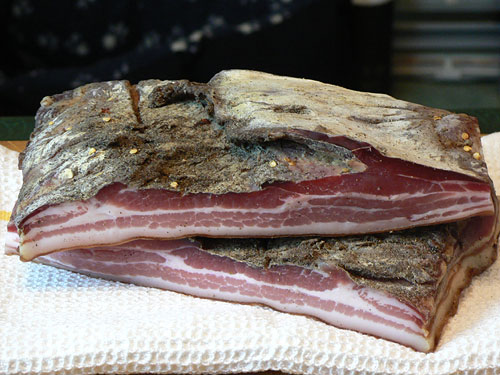
This Pancetta cuts right back on the spices letting the meat shine through.
If you make it, try to get a very thick piece of belly pork from the butcher; the one I used wasn’t really thick enough because the shrinkage is quite considerable. It looks thicker in the photo than it actually is. What looks like green/black mould is actually beneficial white mould on top of the powdered black pepper that I used because I was too lazy to grind the coarse black pepper that I included in the recipe!
Trim the belly well before curing – whether you remove the skin at this stage, or after drying, is up to you. Remove the flap where the ribs have been and any pieces of meat that are between the ribs, you’ll only end up throwing them away after drying. In fact, it’s best to have the bones taken out as a sheet you’ll then be able to use the trim in sausage or pork pies and save wastage.
Pancetta di Thurlaston
Weigh the Pork Belly and mix the following percentages of its weight:
Salt 2.4%
Muscodavo Sugar 0.6%
Cure #2 0.24%
Ground Black Pepper 0.24%
White Pepper 0.07%
Crushed Juniper Berries 0.07%
Dry Thyme 0.07%
Garlic Powder 0.07%
Mix the cure ingredients together and rub it into all of the pork belly. Use about 85% on the meat side and 15% on the fat/skin. Put the meat into a food-grade plastic bag and put it into the fridge to cure. Turn the meat over every couple of days and give it a rub through the bag.
After 7 days, rinse (not soak) the meat and dry it off. Mix 1 tbsp roughly ground black pepper and 3 crushed dried chilli’s together and rub this onto the meat side of the pancetta.
Ideally, hang it at a temperature of 12 – 15°C with a relative humidity of about 75% for a minimum of 2 weeks, or until it’s lost about 30% of its weight. If this isn’t possible it will probably be OK in the fridge, but the lower humidity may cause it to dry too quickly. If this appears to be the case you may need to wrap it loosely in something like baking parchment or greaseproof paper.
There’s also no reason why this cannot be used as fresh bacon after just a few days of drying. In this case use 0.24% of Cure #1 instead of Cure #2.
To make the calculations easy, you can use this online calculator: